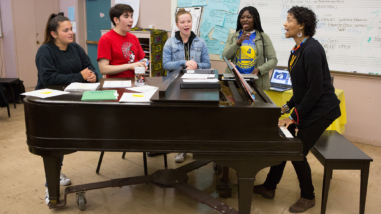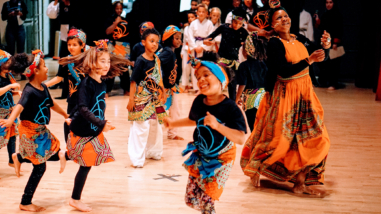The promise of arts advocacy

I remember being the most hated person in the room. It was 2014—before I joined the Hewlett Foundation as a program officer for the Performing Arts Program—and I was an arts education advocate working on San Francisco’s Proposition C, the reauthorization of both the Public Education Enrichment Fund (PEEF) and the Children’s Fund. Both set-asides in the city’s general fund support arts education opportunities for young people in San Francisco—in and out of school, respectively. I had, with a lot of help from colleagues, written a white paper about the role of the arts in PEEF’s reauthorization and was presenting it to a working group made up of advocates, city workers and school district staff. In the paper, we argued for many changes to PEEF, one of which was more money for arts education in the San Francisco Unified School District. Implicitly, that meant less PEEF funds for other worthy causes, like physical education, school nurses and student counseling. The way I saw it: I was an advocate. No one else was going to ask for it. Go big or go home, right?
My hands shook as I read the white paper to a room of stoic faces. In my head, I heard the unspoken objections of others in the room: “But – you can’t take that money! The arts already have enough! Why would you ask for more? What about all the other things that are more important?” The tension grew, and I finished. No one talked to me afterward. It felt, in a word, awful. Later, a colleague and I presented the white paper to Mayor Ed Lee, along with other advocates and their requests. In the end, our allocation suggestion was ignored completely by those writing the legislation, although many of our other suggestions were included. The proportion of arts funding in PEEF remained the same as before. Prop C passed with 74.5 percent. We succeeded in increasing the funding of PEEF overall, but did not succeed in increasing funding for the arts exclusively. The revised PEEF is a much stronger version: more money for public education, and stronger protections for that money.
Looking back, I wouldn’t do it exactly the same way; it was a rookie move to ruffle so many feathers without a backup plan. But the most important thing I learned was the power of asking—clearly, reasonably, resolutely—at a time when it mattered. I had the impression that no one expected an arts advocate to say, “This isn’t enough.” No one had expected an arts advocate at the table at all. And that’s a problem: arts leaders are often not present in these advocacy moments, whether they’re issues that directly affect the arts or other issues that affect the people and places arts leaders care about.
To date, the Performing Arts Program has supported advocacy in one area—through our arts education grantmaking. Recently refreshed, the Arts Education Policy and Advocacy sub-strategy has taught us a lot about how grantees achieving their advocacy goals can have significant impacts on our long-term goal of ensuring broad student participation in arts education. At a time when the arts sector and Bay Area are being reordered by economic inequality, demographic change and extensive changes in how people participate in the arts, we’ve been thinking a lot about what the Bay Area arts sector, and our role, might look like with an expanded view of arts advocacy. Our Performing Arts Program strategy refresh process seemed an ideal opportunity to begin this inquiry.
With this formidable question in mind, we commissioned two arts advocacy reports from Vogl Consulting:
Current Perspectives in Arts Advocacy & How to Better Support it in the Bay Area. This summary of interviews with 12 arts and culture advocates and government officials provides a compelling picture of what advocacy looks like across the Bay Area’s diverse arts landscape. It highlights very different advocacy environments and needs, suggesting that a regional approach to arts advocacy would be challenging. The report also provides five great suggestions about how to strengthen arts advocacy. The first highlights the danger of advocating for the arts and artists as a special class, and the second speaks to the need for art leaders to get involved in issues beyond the arts. The report is by no means comprehensive – after all, 12 people cannot represent such a complex topic or region. However, it is illuminating and has given the Performing Arts Program some clear signals about where it can begin and what to avoid as we move to expand our support for advocacy beyond arts education.
Bay Area Arts Advocacy: A Historical Overview. This report provides a partial snapshot of the Bay Area’s arts advocacy history, sourced from 25 advocates and government officials answering the question: What are the public policy moments (federal, state and local) that shaped the Bay Area nonprofit arts ecosystem we have today? The list of “policy moments” is curated to provide some geographic breadth. This report provides two important insights. First, the policies that have most affected the arts, for both better and worse, have often not been arts policies at all. For example, the Works Progress Administration (WPA) and Prop 13 have profoundly shaped our current context. Second, putting together this report illuminated one thing for us loud and clear: we still have a lot to learn about arts advocacy in the Bay Area.
What else did we learn from this research? I won’t spoil it for you, except to say that the arts sector’s advocacy efforts have not been as effective as they could have. Building our collective arts advocacy chops means that arts leaders (ourselves included) not only need to improve our advocacy skills, we need to do so in ways that cultivate allies and build real bridges between the arts and other interests and groups. Yes, knowledge and training about what is permissible advocacy is needed. What is even more important, however, is to understand and demonstrate that every artist and arts leader is a civic leader, too. We still have a lot to learn and to think about when it comes to arts advocacy, but we’re excited about where it could lead.
I was lucky in 2014. My employer at the time, Performing Arts Workshop, had a board-approved mandate to engage in advocacy for arts education. The board understood that we could have the best program in the world, but our impact would always be limited if institutional barriers to arts education remained in place. That moment in 2014 has stuck with me. Now, as a mother and resident of San Francisco, I am proud to say that my child will benefit directly from the proposition I helped to pass five years ago.



